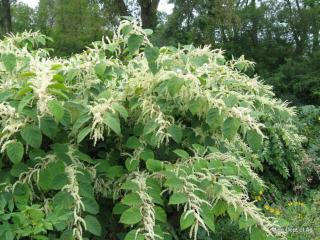Invasive Plants

Invasive plants reproduce easily and spread fast; are non-native and crowd out our native plants, causing environmental and economic harm. Japanese knotweed pictured here, is one of the most common and fast growing invasives plants.
Why Worry?
Many of these exotic plants caught a free ride to Falmouth. Here, they are away from natural enemies that existed in their home range (insects, diseases, etc.) and outgrow and crush Falmouth’s native plants.
• These invasive plants can escape from our cultivated backyards and overrun sensitive natural habitats.
• Invasive plants outgrow native species and agricultural crops, causing billions of dollars of damage each year. They affect forests, wetlands, lakes, streams, croplands, and pastures.
• After loss of habitat, invasive species are the second greatest threat to global biodiversity.Invading plants out-compete native species for sunlight, nutrients, and space. They change animal habitat by eliminating native foods that animals and migrating birds need for survival, altering cover, and destroying nesting opportunities.
• Invasive plants threaten Maine’s natural and working landscapes. Their aggressive growth degrades our recreational experiences, our agriculture, and our forestry.
• Certain invasive plants (barberry and honeysuckle) are associated with increased levels of Lyme disease. They can harbor up to eight times as many deer tick larvae as native species.
For more information on how to identify, control, and substitute:
An Invasives Brochure was prepared by the Conservation Commission.
Gardening to Conserve Maine’s Native Landscape: Plants to Use and Plants to Avoid
"Plants Out of Place: Invasive Plant Ecology and Management" Presentation by the Maine Natural Areas Program.
The Maine Invasives Species Network (MISN) brings together research, education, and outreach professionals who work with invasive species, both plants and insects, in Maine. Their website can be found here.
The Town has also developed an Invasives Management Plan, attachment below, which is the tool used to prioritize and manage our rights of ways, public lands and open spaces, and town facilities each year.
| Attachment | Size |
|---|---|
| 478.42 KB |

